Historical Evolution of Sources and Pollution Levels of Heavy Metals in the Sediment of the Shuanglong Reservoir, China
Abstract
1. Introduction
2. Materials and Methods
2.1. Study Area
2.2. Sample Collection
2.3. Sample Analysis
2.3.1. Isotopic Determination and Dating
2.3.2. Determination of Heavy Metals
2.3.3. Determination of Physicochemical Parameters of Sediment
2.4. Statistical Analysis
2.5. Pollution Indices
2.5.1. Geo-accumulation Index ()
2.5.2. Single Pollution Index (Pi) and Pollution Load Index (PLI)
2.5.3. Potential Ecological Risk Index (RI)
2.5.4. Nemerow Index (PN)
3. Results and Discussion
3.1. Core Chronology
3.2. Heavy Metals in Vertical Profile
- (1)
- 1944–1964 (−60~−49 cm). This stage covers the earliest years of the People’s Republic of China. The heavy metal content was generally low and rising, and the contents of As, Cr, and Hg fluctuated slightly;
- (2)
- 1965–2004 (−48~−13 cm). This stage exhibited a wide range of heavy metal contents. Most elements’ content increased as a result of the implementation of the ”Great Leap Forward“ and ”Reform and Opening“, with the overall concentrations of Cu, Ni, Zn, As, and Cr being higher than in the first stage. With increasing time, the Hg content first increased and then decreased. During the 1970s, serious incidents of Hg pollution occurred in Northeast China and Hebei Province due to the extensive exploitation of Hg ore and the usage of Hg in industrial processes [30]. Thus, the relevant departments have strengthened the prevention and management of Hg pollution. Furthermore, before the 1980s, Pb concentrations increased as a result of soil erosion caused by the widespread destruction of forests in the Dianchi watershed during the Cultural Revolution. Later, as land use was rationalized, Pb pollution decreased;
- (3)
- 2005–2012 (−12~−4 cm). During this stage, in China, the living standards significantly improved, the area of green land and environmental investment gradually increased, land-use patterns were rationalized, and environmental policies and regulations achieved specific effects [31]. For instance, in January 2005, the first wave of environmental protection events was officially launched, during which 30 illegal engineering projects were stopped. Moreover, many industrial policies were promulgated to promote the sustainable development of eco-industrial parks and implement the basic national policy of resource conservation and environmental protection [16]. Moreover, eight sewage treatment plants were built in the Dianchi watershed. Thus, measures for the control of pollution sources and contaminant treatment were vigorously implemented, so that the concentration of heavy metals was significantly reduced in the reservoir. Furthermore, in the 1990s, the reconstruction and expansion of urban roads promoted the increase in the number of motor vehicles in operation, which increased the Pb emissions [32,33];
- (4)
- 2013–2015 (−3~−1 cm). In this stage, the increase in per capita income led to large changes in lifestyle, and the rise of tourism in Yunnan drove the development of scenic spots and economies around the Shuanglong reservoir. This, combined with the effects of the vast tributaries that flow through urban areas, industrial enterprises, and agricultural areas, led to an increase in the content of seven heavy metals.
3.3. Sources of Heavy Metal Pollution
3.4. Assessment of Heavy Metal Contamination
4. Conclusions
Author Contributions
Funding
Acknowledgments
Conflicts of Interest
References
- Schneider, L.; Maher, W.; Potts, J.; Batley, G.; Taylor, A.; Krikowa, F.; Charition, A.; Zawadzki, A.; Heijnis, H.; Gruber, B. History of metal contamination in Lake Illawarra, NSW, Australia. Chemosphere 2015, 119, 377–386. [Google Scholar] [CrossRef]
- Wu, S.S.; Han, R.M.; Yang, H.; Wang, Q.J.; Bi, F.Z.; Wang, Y.H. A century−long trend of metal pollution in the Sheyang River, on the coast of Jiangsu (China), reconstructed from sedimentary record. Chem. Ecol. 2017, 33, 1–17. [Google Scholar] [CrossRef]
- Nguyen, T.T.H.; Zhang, W.G.; Li, Z.; Li, J.; Ge, C.; Liu, J.Y.; Bai, X.X.; Feng, H.; Yu, L.Z. Assessment of heavy metal pollution in Red River surface sediments, Vietnam. Mar. Pollut. Bull. 2016, 113, 513–519. [Google Scholar] [CrossRef] [PubMed]
- Singh, K.P.; Malik, A.; Sinha, S.; Singh, V.K.; Murthy, R.C. Estimation of source of heavy metal contamination in sediments of Gomti River (India) using principal component analysis. Water Air Soil Pollut. 2005, 166, 321–341. [Google Scholar] [CrossRef]
- Ali, M.M.; Ali, M.L.; Islam, M.S.; Rahman, M.Z. Preliminary assessment of heavy metals in water and sediment of Karnaphuli River, Bangladesh. Environ. Nanotechnol. Monit. Manag. 2016, 5, 27–35. [Google Scholar] [CrossRef]
- Chen, H.Y.; Chen, R.H.; Teng, Y.G.; Wu, J. Contamination characteristics, ecological risk and source identification of trace metals in sediments of the Le’an River (China). Ecotoxicol. Environ. Saf. 2016, 125, 85–92. [Google Scholar] [CrossRef] [PubMed]
- Reddy, M.S.; Basha, S.; Sravan Kumar, V.G.; Joshi, H.V.; Ramachandraiah, G. Distribution, enrichment and accumulation of heavy metals in coastal sediments of Alang−Sosiya ship scrapping yard, India. Mar. Pollut. Bull. 2004, 48, 1055–1059. [Google Scholar] [CrossRef]
- Wang, X.L.; Zhang, L.; Zhao, Z.H.; Cai, Y.J. Heavy metal pollution in reservoirs in the hilly area of southern China: Distribution, source apportionment and health risk assessment. Sci. Total Environ. 2018, 634, 158–169. [Google Scholar] [CrossRef]
- Wang, G.; Li, J.; Sun, W.; Xue, B.; Yinglan, A.; Liu, T. Non−point source pollution risks in a drinking water protection zone based on remote sensing data embedded within a nutrient budget model. Water Res. 2019, 157, 238–246. [Google Scholar] [CrossRef]
- Xiong, Y.Q.; Wu, F.C.; Fang, J.D.; Fang, J.D.; Wang, L.F.; Li, Y.; Liao, H.Q. Organic geochemical record of environmental changes in Lake Dianchi, China. J. Paleolimnol. 2010, 44, 217–231. [Google Scholar] [CrossRef]
- Dearing, J.A.; Jones, R.T. Coupling temporal and spatial dimensions of global sediment flux through lake and marine sediment records. Glob. Planet. Chang. 2003, 39, 147–168. [Google Scholar] [CrossRef]
- Chassiot, L.; Francus, P.; Coninck, A.D.; Lajeunesse, P.; Cloutier, D.; Labarre, T. Spatial and temporal patterns of metallic pollution in Québec City, Canada: Sources and hazard assessment from reservoir sediment records. Sci. Total Environ. 2019, 673, 136–147. [Google Scholar] [CrossRef] [PubMed]
- Christophoridis, C.; Bourliva, A.; Evgenakis, E.; Papadopoulou, L.; Fytianos, K. Effects of anthropogenic activities on the levels of heavy metals in marine surface sediments of the Thessaloniki Bay, Northern Greece: Spatial distribution, sources and contamination assessment. Microchem. J. 2019, 149, 104001. [Google Scholar] [CrossRef]
- Ganugapenta, S.; Nadimikeri, J.; Chinnapolla, S.R.R.B.; Ballari, L.; Madiga, R.; Nirmala, K.; Tella, L.P. Assessment of heavy metal pollution from the sediment of Tupilipalem Coast, southeast coast of India. Int. J. Sediment Res. 2018, 33, 294–302. [Google Scholar] [CrossRef]
- Nazneen, S.; Singh, S.; Raju, N.J. Heavy metal fractionation in core sediments and potential biological risk assessment from Chilika lagoon, Odisha state, India. Quat. Int. 2019, 507, 370–388. [Google Scholar] [CrossRef]
- Yang, G.H.; Song, Z.G.; Sun, X.L.; Chen, C.L.; Ke, S.; Zhang, J.B. Heavy metals of sediment cores in Dachan Bay and their responses to human activities. Mar. Pollut. Bull. 2020, 150, 110764. [Google Scholar] [CrossRef] [PubMed]
- Tang, H.J.; Ke, Z.X.; Yan, M.T.; Wang, W.J.; Nie, H.Y.; Li, B.X.; Zhang, J.P.; Xu, X.G.; Wang, J. Concentrations, Distribution, and Ecological Risk Assessment of Heavy Metals in Daya Bay, China. Water 2018, 10, 780. [Google Scholar] [CrossRef]
- Mazurek, R.; Kowalska, J.B.; Gąsiorek, M.; Zadrożny, P.; Wieczorek, J. Pollution indices as comprehensive tools for evaluation of the accumulation and provenance of potentially toxic elements in soils in Ojców National Park. J. Geochem. Explor. 2019, 201, 13–30. [Google Scholar] [CrossRef]
- Zhang, Y.; Meng, W.; Guo, C.S.; Xu, J.; Yu, T.; Fan, W.H.; Li, L. Determination and partitioning behavior of perfluoroalkyl carboxylic acids and perfluorooctanesulfonate in water and sediment from Dianchi Lake, China. Chemosphere 2012, 11, 1292–1299. [Google Scholar] [CrossRef] [PubMed]
- Fang, J.D.; Wu, F.C.; Xiong, Y.Q.; Li, F.S.; Du, X.M.; An, D.; Wang, L.F. Source characterization of sedimentary organic matter using molecular and stable carbon isotopic composition of n−alkanes and fatty acids in sediment core from Lake Dianchi, China. Sci. Total Environ. 2014, 473–474, 410–421. [Google Scholar] [CrossRef]
- Last, W.M.; Smol, J.P. Tracking Environ−Mental Change Using Lake Sediments, Volume 1: Basin Analysis, Coring, and Chronological Techniques; Kluwer Academic Publishers: Dordrecht, The Netherlands, 2001; pp. 171–196. [Google Scholar]
- Muller, G. Index of geo−accumulation in sediments of the Rhine River. J. Geol. 1969, 2, 108–118. [Google Scholar]
- Hou, D.K.; He, J.; Lv, C.W.; Ren, L.M.; Fan, Q.Y.; Wang, J.H.; Xie, Z.L. Distribution characteristics and potential ecological risk assessment of heavy metals (Cu, Pb, Zn, Cd) in water and sediments from Lake Dalinouer, China. Ecotoxicol. Environ. Saf. 2013, 93, 135–144. [Google Scholar] [CrossRef] [PubMed]
- Tomlinson, D.L.; Wilson, J.G.; Harris, C.R.; Jeffrey, D.W. Problems in the assessment of heavy−metals in estuaries and the formation of a pollution index. Helgoländer Meeresunters. 1980, 33, 566–575. [Google Scholar] [CrossRef]
- Hakanson, L. An ecological risk index for aquatic pollution control a sediment ecological approach. Water Res. 1980, 14, 975–1001. [Google Scholar] [CrossRef]
- Sun, C.Y.; Zhang, Z.X.; Cao, H.N.; Xu, M.; Xu, L. Concentrations, speciation, and ecological risk of heavy metals in the sediment of the Songhua River in an urban area with petrochemical industries. Chemosphere 2019, 219, 538–545. [Google Scholar] [CrossRef]
- Zhang, L.; Sovacool, B.K.; Ren, J.Z.; Ely, A. The Dragon awakens: Innovation, competition, and transition in the energy strategy of the People’s Republic of China, 1949−2017. Energy Policy 2017, 108, 634–644. [Google Scholar] [CrossRef]
- Wan, D.J.; Song, L.; Mao, X.; Yang, J.S.; Jin, Z.D.; Yang, H.D. One−century sediment records of heavy metal pollution on the southeast Mongolian Plateau: Implications for air pollution trend in China. Chemosphere 2019, 220, 539–545. [Google Scholar] [CrossRef]
- Wu, S.Z.; Huang, D.S.; Liu, Z.C.; Shen, X.Y.; Yuan, Q.D. 40 Years Evolution of the Relationship Between Environmental Protection and Economic Development in China. Environ. Prot. 2018, 46, 14–20. (In Chinese) [Google Scholar]
- Zhang, L.; Wong, M.H. Environmental mercury contamination in China: Sources and impacts. Environ. Int. 2007, 33, 108–121. [Google Scholar] [CrossRef]
- Zhou, J.X.; Wang, J.; Wang, P.F.; Hua, Y.; Liu, B.; Li, J. Wavelet Analysis of Water Quality Changes in Dianchi Lake during the past 7a. Procedia Earth Planet. Sci. 2012, 5, 280–288. [Google Scholar] [CrossRef]
- Cherry, C.R.; Yang, H.T.; Jones, L.R.; He, M. Dynamics of electric bike ownership and use in Kunming, China. Transport Policy 2016, 45, 127–135. [Google Scholar] [CrossRef]
- Jia, P.Q.; Zhang, W.B.; Liu, Q.G. Lake fisheries in China: Challenges and opportunities. Fish. Res. 2013, 140, 66–72. [Google Scholar] [CrossRef]
- Macdonald, D.D.; Ingersoll, C.G.; Berger, T.A. Development and evaluation of consensus−based Sediment Quality guidelines for freshwater ecosystems. Arch. Environ. Contam. Toxicol. 2000, 39, 20–31. [Google Scholar] [CrossRef] [PubMed]
- Gu, Y.G.; Gao, Y.P. An unconstrained ordination− and GIS−based approach for identifying anthropogenic sources of heavy metal pollution in marine sediments. Mar. Pollut. Bull. 2019, 146, 100–105. [Google Scholar] [CrossRef] [PubMed]
- Lee, P.K.; Kang, M.J.; Yu, S.Y.; Ko, K.S.; Ha, K.; Shin, S.C.; Park, J.H. Enrichment and geochemical mobility of heavy metals in bottom sediment of the Hoedong reservoir, Korea and their source apportionment. Chemosphere 2017, 184, 74–85. [Google Scholar] [CrossRef] [PubMed]
- Deng, M.H.; Yang, X.E.; Dai, X.; Zhang, Q.; Malik, A.; Sadeghpour, A. Heavy metal pollution risk assessments and their transportation in sediment and overlay water for the typical Chinese reservoirs. Ecol. Indic. 2020, 112, 106166. [Google Scholar] [CrossRef]
- Duzgoren−Aydin, N.S.; Li, X.D.; Wong, S.C. Lead contamination and isotope signatures in the urban environment. Environ. Int. 2004, 30, 209–217. [Google Scholar] [CrossRef]
- Qiao, Y.M.; Huang, C.J. A study on concentration and distribution characteristics of heavy metals in surface sediment of the Shantou Estuary in China. Acta Oceanol. Sin. 2009, 31, 106–116. [Google Scholar]
- Wang, S.R.; Jin, X.C.; Bu, Q.Y.; Zhou, X.N.; Wu, F.C. Effects of particle size, organic matter and ionic strength on the phosphate sorption in different trophic lake sediments. J. Hazard. Mater. 2006, 128, 95–105. [Google Scholar] [CrossRef]
- Men, C.; Liu, R.M.; Wang, Q.R.; Guo, L.J.; Shen, Z.Y. The impact of seasonal varied human activity on characteristics and sources of heavy metals in metropolitan road dusts. Sci. Total Environ. 2018, 637–638, 844–854. [Google Scholar] [CrossRef]
- Xu, H.; Zhu, Y.; Wang, L.; Lin, C.; Jang, C.; Zhou, Q.; Yu, B.; Wang, S.X.; Xing, J.; Yu, L. Source contribution analysis of mercury deposition using an enhanced CALPUFF−Hg in the central Pearl River Delta, China. Environ. Prot. 2019, 250, 1032–1043. [Google Scholar] [CrossRef] [PubMed]
- Bonotto, D.M.; Wijesiri, B.; Vergotti, M.; da Silveira, E.G.; Goonetilleke, A. Assessing mercury pollution in Amazon River tributaries using a Bayesian Network approach. Ecotoxicol. Environ. Saf. 2018, 166, 354–358. [Google Scholar] [CrossRef] [PubMed]
- Drevnick, P.E.; Cooke, C.A.; Barraza, D.; Blais, J.M.; Coale, K.H.; Cumming, B.F.; Curtis, C.J. Spatiotemporal patterns of mercury accumulation in lake sediments of western North America. Sci. Total Environ. 2016, 568, 1157–1170. [Google Scholar] [CrossRef] [PubMed]
- Zhang, H.X.; Huo, S.L.; Yeager, K.M.; Xi, B.D.; Zhang, J.T.; Wu, F.C. A Historical Sedimentary Record of Mercury in a Shallow Eutrophic Lake: Impacts of Human Activities and Climate Change. Engineering 2019, 5, 296–304. [Google Scholar] [CrossRef]
- Wang, Y.H.; Yang, H.; Zhang, J.X.; Xu, M.N.; Wu, C.B. Biomarker and stable carbon isotopic signatures for 100−200year sediment record in the Chaihe catchment in southwest China. Sci. Total Environ. 2015, 502, 266–275. [Google Scholar] [CrossRef]
- Yunnan Provincial Bureau of Statistics. Available online: http://www.stats.yn.gov.cn/ (accessed on 16 June 2019).
- Mil−Homens, M.; Blum, J.; Canário, J.; Caetano, M.; Costa, A.M.; Lebreiro, S.M.; Trancoso, M.; Richter, T.; De Stigter, H.; Johnson, M.; et al. Tracing anthropogenic Hg and Pb input using stable Hg and Pb isotope ratios in sediments of the central Portuguese Margin. Chem. Geol. 2013, 336, 62–71. [Google Scholar] [CrossRef]
- Gmochowska, W.; Pietranik, A.; Tyszka, R.; Ettler, V.; Mihaljevič, M.; Długosz, M.; Walenczak, K. Sources of pollution and distribution of Pb, Cd and Hg in Wrocław soils: Insight from chemical and Pb isotope composition. Geochemistry 2019, 79, 434–445. [Google Scholar] [CrossRef]
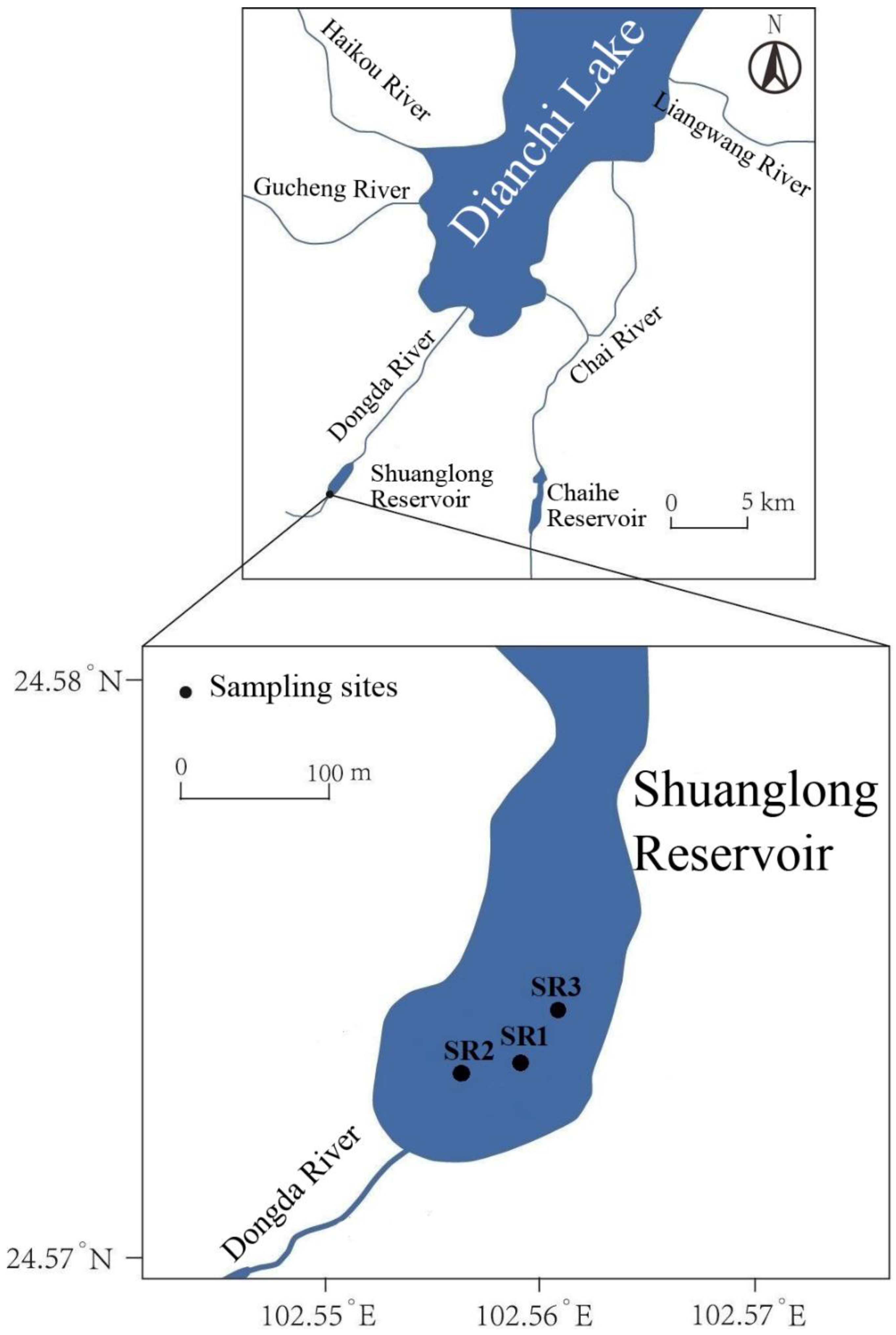
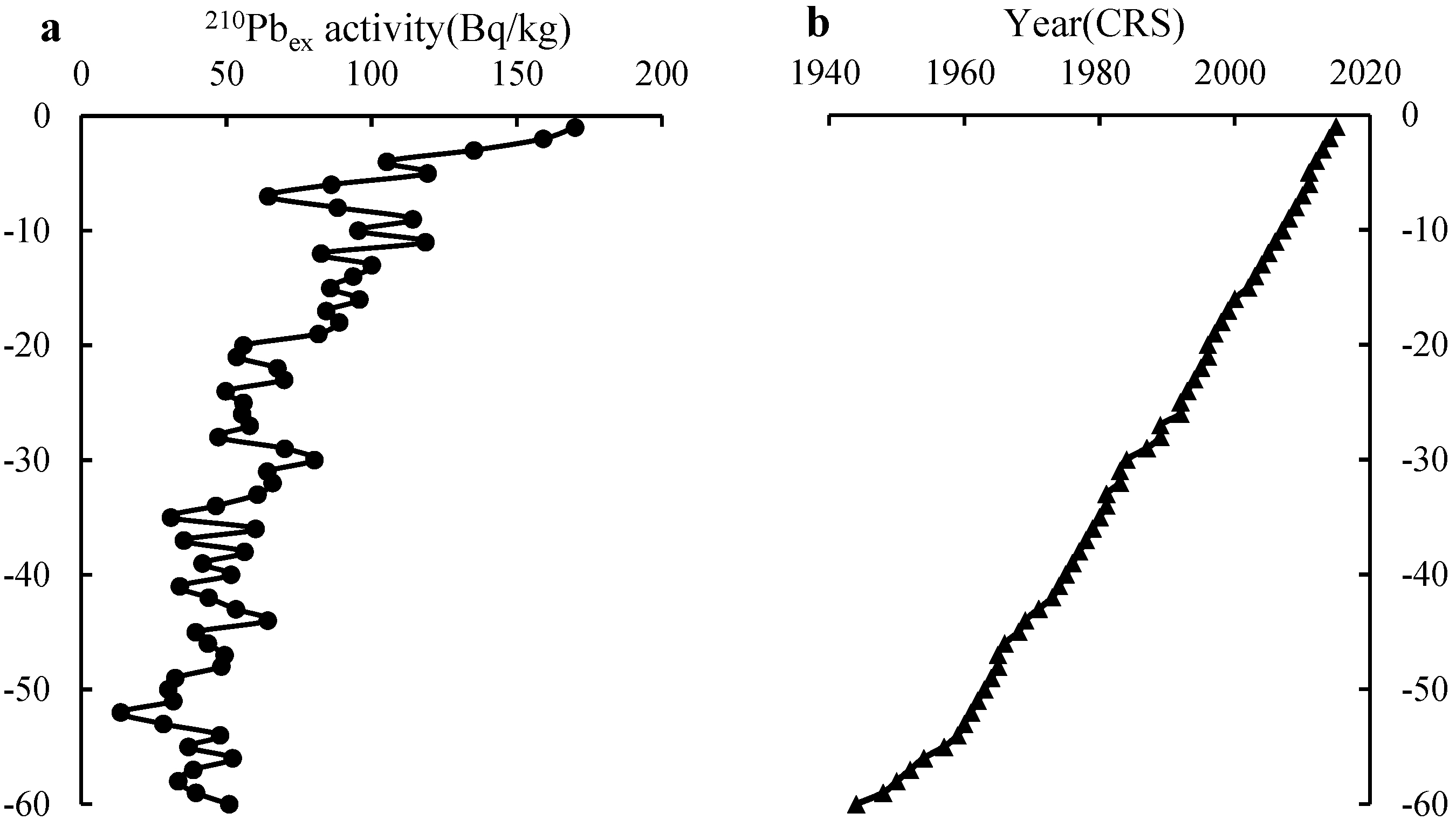
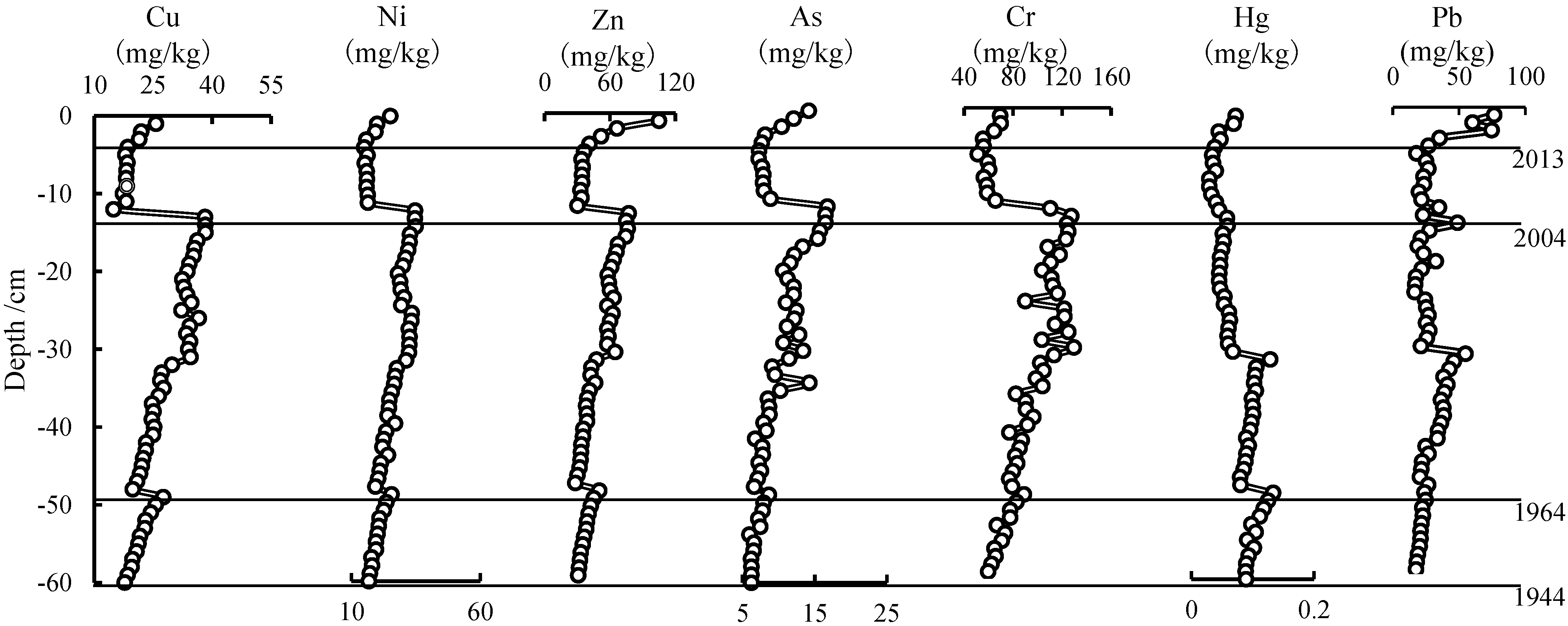

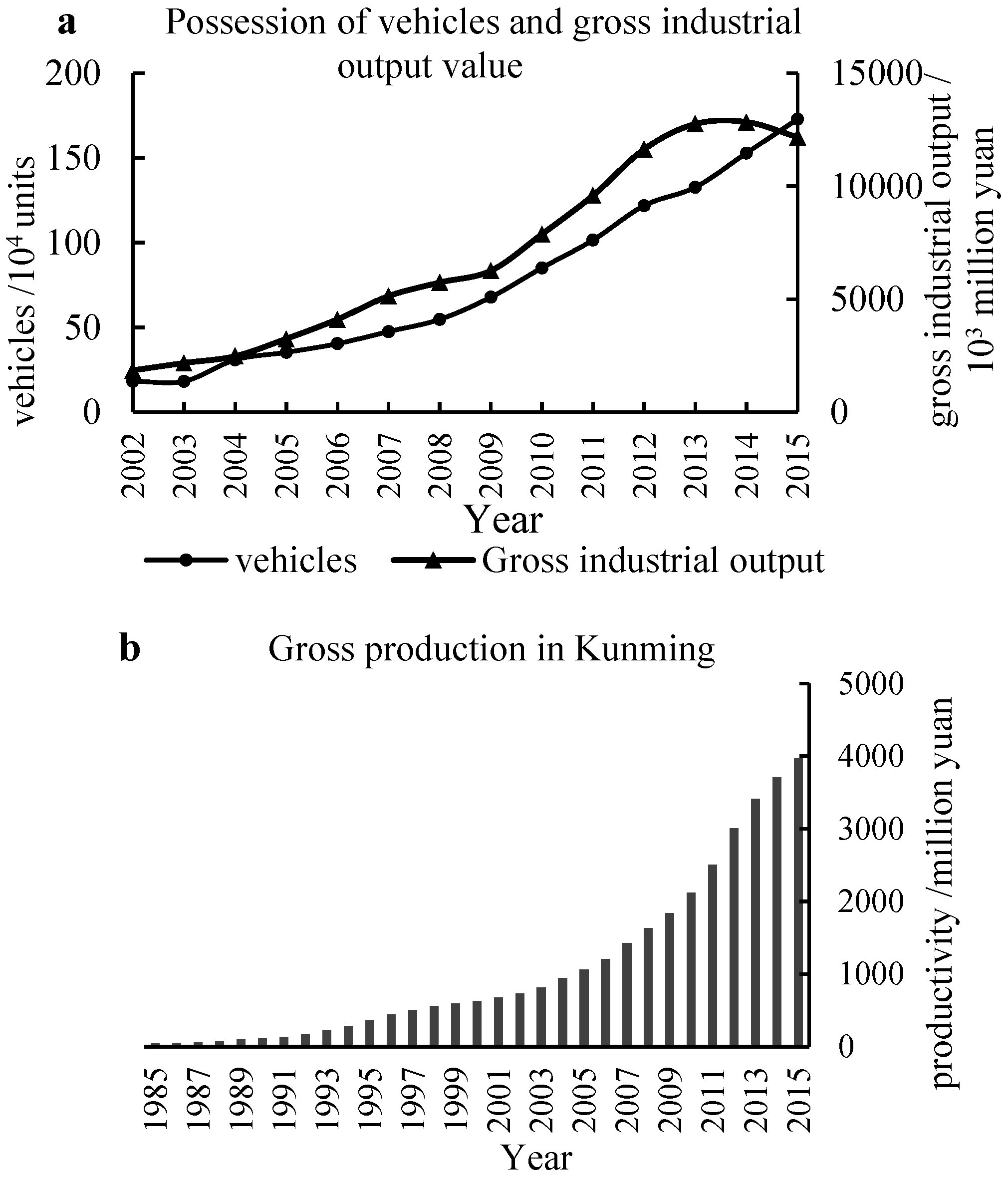
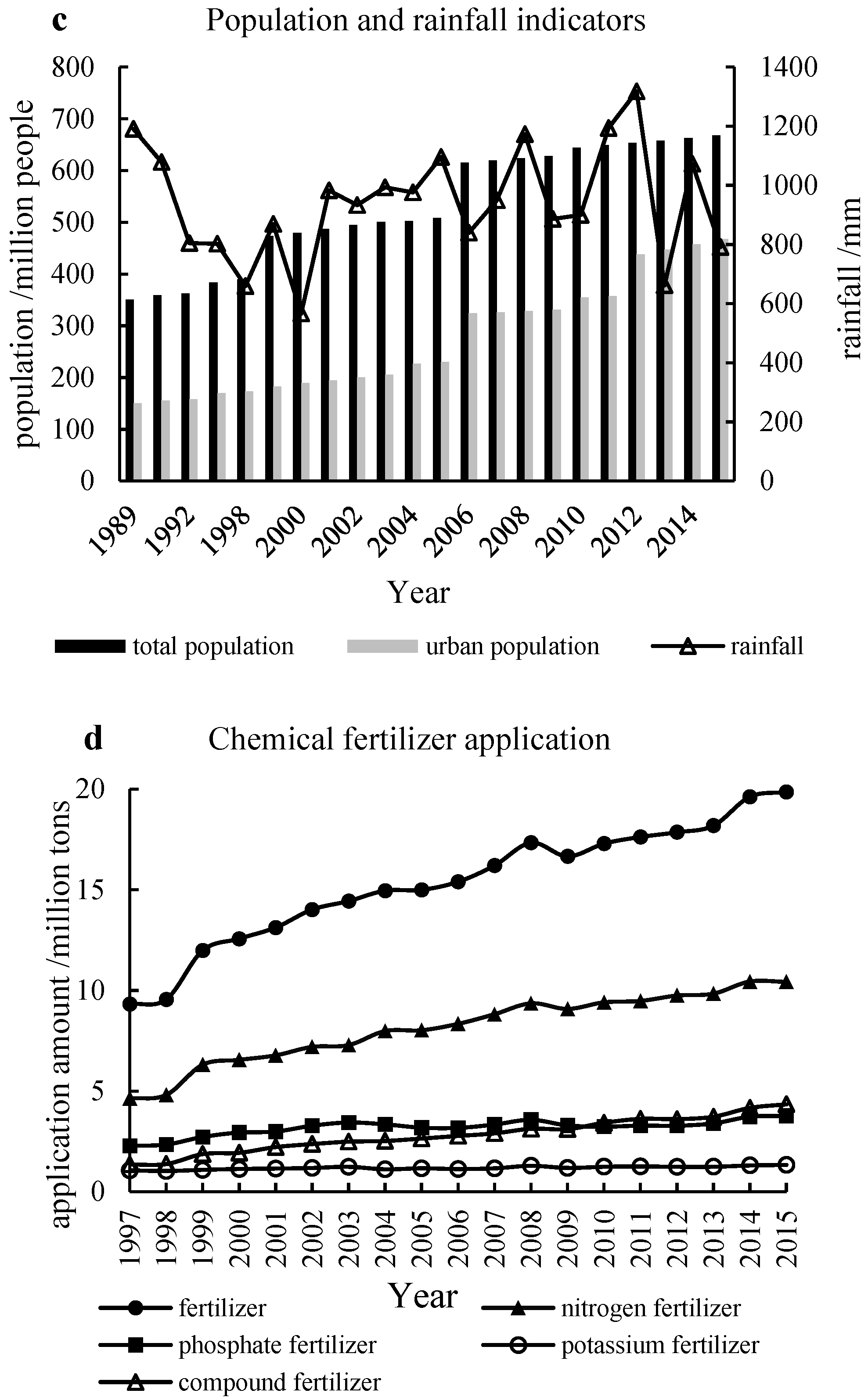
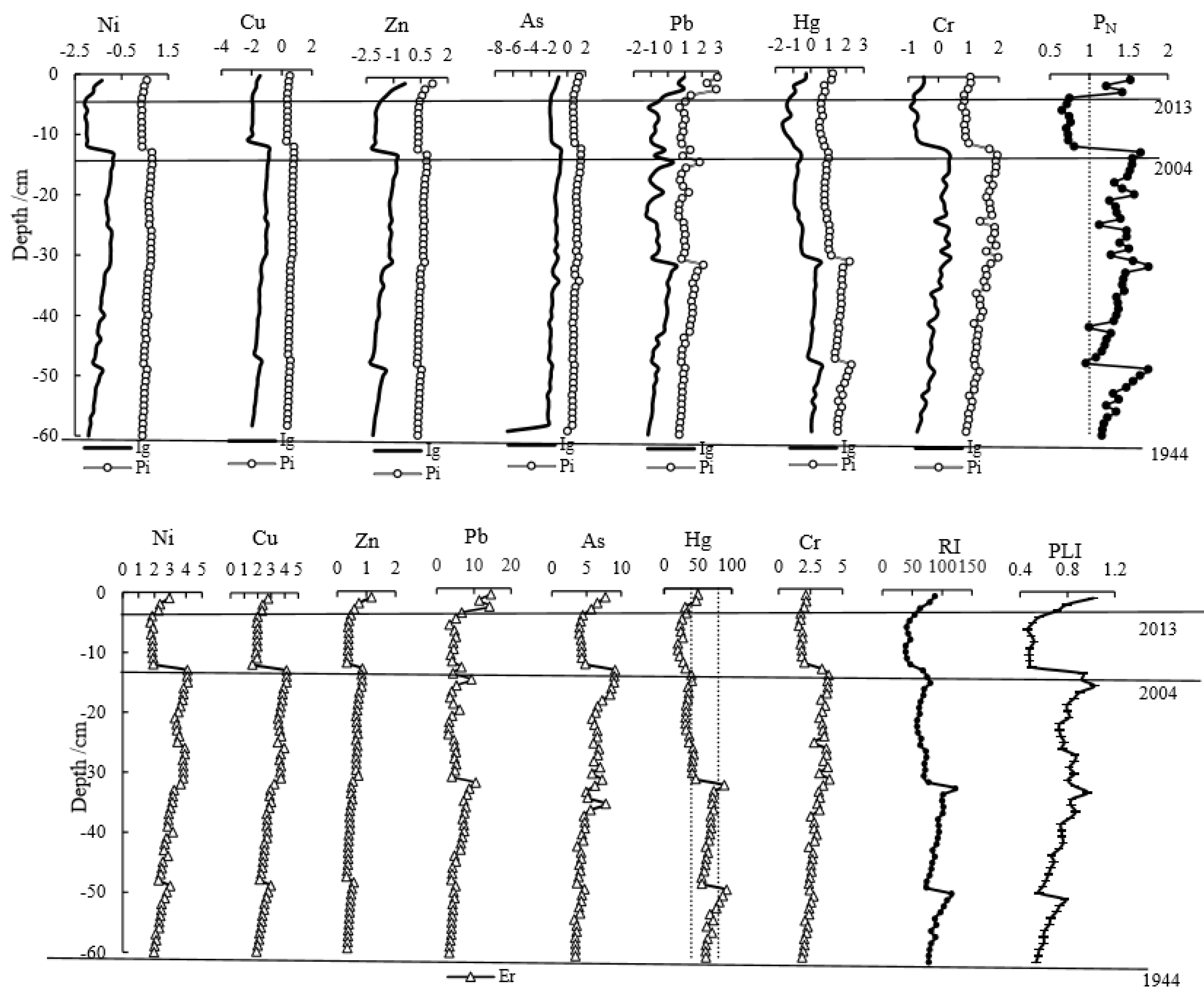
| Heavy Metals | As | Cr | Cu | Hg | Ni | Pb | Zn |
|---|---|---|---|---|---|---|---|
| Background values (mg/kg) | 18.4 | 65.2 | 46.3 | 0.058 | 42.5 | 26.2 | 89.7 |
| 10 | 2 | 5 | 40 | 5 | 5 | 1 | |
| a | 31.60 | 22.70 | 121.00 | 9.79 | 43.40 | 0.18 | 35.80 |
| b | 149.00 | 48.60 | 459.00 | 33.00 | 111.00 | 1.06 | 128.00 |
| Coefficient of variation (CV) | 0.31 | 0.26 | 0.26 | 0.38 | 0.25 | 0.44 | 0.34 |
| Rank | Pollution Level | Pollution Level | Pollution Level | Pollution Level | Pollution Level | PLI | Pollution Level | |||||
|---|---|---|---|---|---|---|---|---|---|---|---|---|
| 0 | clean | (0.7) | clean | 40) | low | clean | (0,150) | low | (,1] | Clean | ||
| 1 | slight | [0.7,1) | warn | [4080) | moderate | slight | [150300) | moderate | (1, | Pollution | ||
| 2 | moderate | ) | slight | [80160) | considerable | [2 | medium | [300600) | considerable | |||
| 3 | medium | ) | moderate | [160320) | heavy | (3,) | heavy | 600,) | serious | |||
| 4 | considerable | ) | heavy | 320, | serious | |||||||
| 5 | heavy | |||||||||||
| 6 | serious |
| Cr | Ni | Cu | Zn | As | Hg | Pb | |
|---|---|---|---|---|---|---|---|
| Cr | 1.000 | ||||||
| Ni | 0.957 ** | 1.000 | |||||
| Cu | 0.937 ** | 0.977 ** | 1.000 | ||||
| Zn | 0.636 ** | 0.748 ** | 0.795 ** | 1.000 | |||
| As | 0.754 ** | 0.802 * | 0.829 ** | 0.866 ** | 1.000 | ||
| Hg | 0.158 | 0.213 | 0.178 | 0.073 | 0.062 | 1.000 | |
| Pb | 0.010 | 0.101 | 0.032 | 0.343 ** | 0.292 * | 0.153 | 1.000 |
| pH | −0.240 | −0.290 * | −0.337 ** | −0.533 ** | −0.625 ** | −0.296 | −0.305 * |
| TOC | −0.193 | −0.078 | −0.036 | 0.533 ** | 0.337 ** | −0.199 | 0.647 ** |
| Vehicles | −0.368 | −0.196 | −0.198 | −0.383 | −0.002 | 0.898 ** | 0.802 ** |
| Gross Industrial output | −0.660 ** | −0.564 * | −0.553 * | −0.064 | −0.388 | 0.791 ** | 0.674 ** |
| Gross production | −0.736 ** | −0.641 ** | −0.641 ** | −0.033 | −0.265 | 0.032 | 0.596 ** |
| Urban population | −0.771 ** | −0.675 ** | −0.681 ** | −0.164 | −0.416 | 0.803 ** | 0.631 ** |
| Fertilizer | −0.755 ** | −0.668 ** | −0.670 ** | −0.191 | −0.449 | 0.907 ** | 0.544 * |
| Nitrogen fertilizer | −0.795 ** | −0.721 ** | −0.720 ** | −0.265 | −0.514 * | 0.859 ** | 0.498 * |
| Phosphate fertilizer | −0.573 * | −0.483 * | −0.503 ** | −0.067 | −0.238 | 0.874 ** | 0.500 * |
| Potassium fertilizer | −0.507 * | −0.386 | −0.376 | −0.080 | −0.180 | 0.828 ** | 0.599 ** |
| Compound fertilizer | −0.729 ** | −0.626 ** | −0.626 ** | −0.112 | −0.411 | 0.901 ** | 0.612 ** |
| Rainfall | 0.319 | 0.322 | 0.270 | 0.232 | 0.274 | −0.337 | −0.147 |
© 2020 by the authors. Licensee MDPI, Basel, Switzerland. This article is an open access article distributed under the terms and conditions of the Creative Commons Attribution (CC BY) license (http://creativecommons.org/licenses/by/4.0/).
Share and Cite
Zhou, Z.; Wang, Y.; Teng, H.; Yang, H.; Liu, A.; Li, M.; Niu, X. Historical Evolution of Sources and Pollution Levels of Heavy Metals in the Sediment of the Shuanglong Reservoir, China. Water 2020, 12, 1855. https://doi.org/10.3390/w12071855
Zhou Z, Wang Y, Teng H, Yang H, Liu A, Li M, Niu X. Historical Evolution of Sources and Pollution Levels of Heavy Metals in the Sediment of the Shuanglong Reservoir, China. Water. 2020; 12(7):1855. https://doi.org/10.3390/w12071855
Chicago/Turabian StyleZhou, Zike, Yongping Wang, Haowei Teng, Hao Yang, Aiju Liu, Menghong Li, and Xiaoyin Niu. 2020. "Historical Evolution of Sources and Pollution Levels of Heavy Metals in the Sediment of the Shuanglong Reservoir, China" Water 12, no. 7: 1855. https://doi.org/10.3390/w12071855
APA StyleZhou, Z., Wang, Y., Teng, H., Yang, H., Liu, A., Li, M., & Niu, X. (2020). Historical Evolution of Sources and Pollution Levels of Heavy Metals in the Sediment of the Shuanglong Reservoir, China. Water, 12(7), 1855. https://doi.org/10.3390/w12071855






